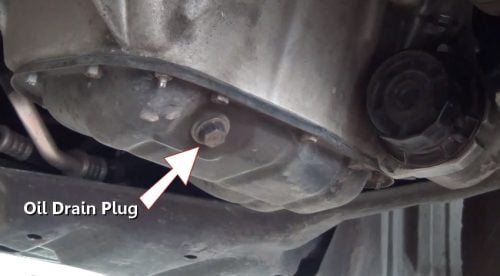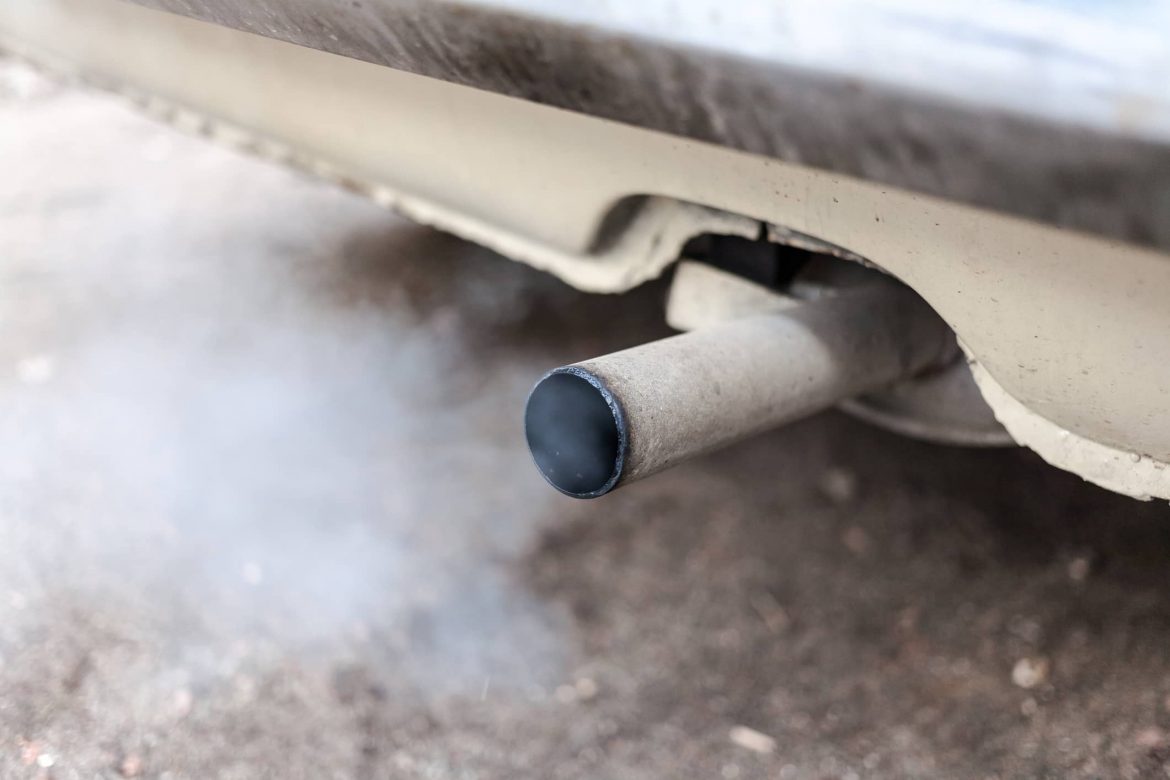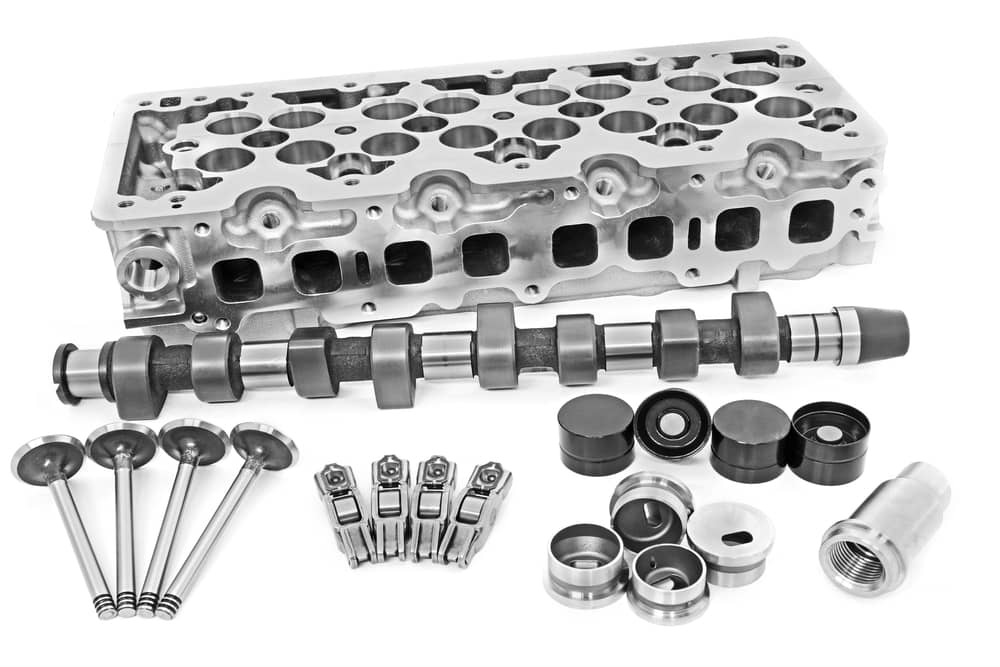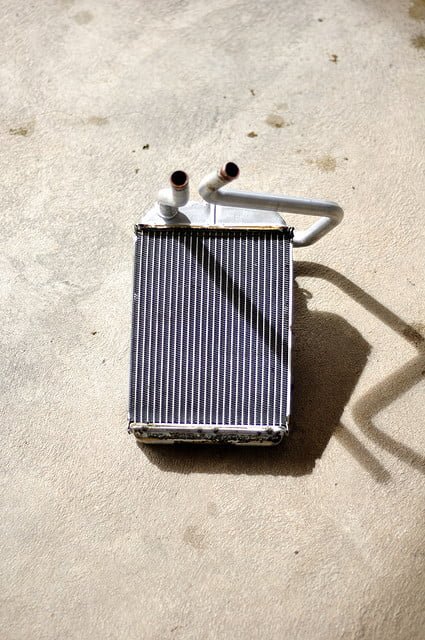Have you seen a few spots of oil on the group under your car every time you pull into your parking spot? Are you one of the few car owners that checks there oil regularly and have noticed the level going down? Maybe you are a weekend mechanic or are just trying to do your own maintenance and discovered some oil on the underside of your car and are trying to figure out where it’s coming from and how to fix it.
Do I have a rear main seal leak?
If you have found oil spots or noticed your engine oil level going down on your dipstick, checking the underside of your vehicle for evidence of the leak is the best place to start. Depending on what kind of car you have, this may be an easy or a difficult task. If you’ve got a newer truck or SUV you may be able to see under it without any difficulty at all. If you have a sports car, or vehicle that rides close to the ground it may require ramps or jack stands to lift the front of the car up to be able to see under it. Also, if you have an older or high mileage vehicle, there may be lots of road grime and gunk, old leaks, spilled oil or other debris caked onto the motor or underside of the vehicle making it difficult to identify the new leak. In this case, consider degreasing your engine or cleaning the undercarriage before starting your leak detection process. Many new car washes offer undercarriage cleaning as part of a premium car wash.
 Once you’ve got your vehicle in a place where you can see under it, let’s identify some of the things you may see. For a starting point, let’s find the oil pan drain plug. Since changing in engine oil is one of the most common things you have to do on your vehicle most vehicle manufactures allow the engine oil pan to be one of the lowest points under your car for easy access. On a truck or SUV you may have to remove a skip plate or shield before you can see this. On the bottom of the oil pan will be the drain plug, which will look like a bolt. Finding this point on your vehicle may take a second but it will likely be about even with the front wheels and about in the middle of the vehicle. Starting at the lowest point on your engine and moving upward is the best way to find an oil leak. Just about any oil leak will eventually make its way down to the oil pan since it is the lowest point. So from here, find the fresh oil and try to trace it up on the engine. Look for a leak starting point, meaning there is no fresh oil leak above that. One you’ve found the highest fresh oil, your problem should be just above that. For oil leaks like these, add BlueDevil Oil Stop Leak to your engine oil to seal the leak.
Once you’ve got your vehicle in a place where you can see under it, let’s identify some of the things you may see. For a starting point, let’s find the oil pan drain plug. Since changing in engine oil is one of the most common things you have to do on your vehicle most vehicle manufactures allow the engine oil pan to be one of the lowest points under your car for easy access. On a truck or SUV you may have to remove a skip plate or shield before you can see this. On the bottom of the oil pan will be the drain plug, which will look like a bolt. Finding this point on your vehicle may take a second but it will likely be about even with the front wheels and about in the middle of the vehicle. Starting at the lowest point on your engine and moving upward is the best way to find an oil leak. Just about any oil leak will eventually make its way down to the oil pan since it is the lowest point. So from here, find the fresh oil and try to trace it up on the engine. Look for a leak starting point, meaning there is no fresh oil leak above that. One you’ve found the highest fresh oil, your problem should be just above that. For oil leaks like these, add BlueDevil Oil Stop Leak to your engine oil to seal the leak.
If it seems that your oil leak starts at the bottom of your engine, and you cannot find evidence of leaking oil above the oil pan, you may have a rear main seal leak. The rear main seal is the seal between your crankshaft and the rear of the engine block just outside of the rear main bearing. Since this seal is just above the rear of your oil pan a leak from it will appear to start there and you will not find oil above the oil pan. A rear main seal leak will cause oil to drip down the back of the oil pan and the front of the transmission bell housing so look for fresh oil right where the engine and transmission are bolted together.
How do I fix a rear main seal leak?
If you think you’ve discovered a leaking rear main seal on your vehicle don’t get scared by all the high quotes from mechanics. You can quickly and easily fix your rear main seal leak using BlueDevil Rear Main Sealer. BlueDevil Rear Main Sealer is a specially formulated oil additive that is safe to stay in your engine oil until your next oil change. BlueDevil Rear Main Sealer will recondition your original rear main seal, stopping your leak without the high repair bills.
BlueDevil Products can be found on Amazon.com or at AutoZone, Advance Auto Parts, O’Reilly Auto Parts, NAPA, and other major auto parts retailers.
48 responses to "Do I Have a Rear Main Seal Leak?"
48 Comments
Leave a Reply
Related Articles




I have used your products successfully for years and believe completely in the repairs they provide. However, I have a question. I have a customer’s Chevy 1500 series truck with a rear main bearing leak in the rear seal. It’s a V8 and the leak is pretty bad. This just isn’t a drip every now and then, it’s a constant drip when the engine in running. I’m not sure your rear main bearing seal stop leak with stop it. Any suggestions other then to replace the seal?
Thanks in advance, Stephen Oakley/Prestige Auto, Houston, TX 77063
Stephen,
Thanks for the kind words and support of our products. Based on your description, your issue may be too severe for our product to repair. There certainly is no harm in trying it out however with something that severe, it will be tough as the seal sounds completely non functional. I would recommend a hard part replacement which is gonna be your best solution, regardless.
If you have any other questions, feel free to call our tech line at 1.888.863.0426
My leak is on the front seal (says the mechanic I took it to) he said it’ll take $200 for labor. Do you have a product that would work for it?
Brittany-
Yes, the best product for you to stop that leak is the BlueDevil Oil Stop Leak. You should notice results after approximately 100 miles of driving once the product has been added.
Thanks,
BDP
This product is the best ,I took my truck to the mechanic to see what the problem was, it was going to cost me around $500.00 to repair the rear main seal,second opinion was to buy a can of blue devel rear main seal which I did and thank god I did ,no more leak in just one hour of driven
I just got the oil changed in a 2007 Nissan Versa (it has less than 83,000 miles), and was told I have a rear main seal leak. How long do I have to wait to use blue devil rear main seal and how often do I have to reapply it?
Lori-
You may add the BlueDevil Rear Main Sealer now and it can be left in the system for the life of the current oil (until your next scheduled oil change). The BlueDevil only needs to be added one time as it is a permanent seal.
Feel free to contact us at 888-863-0426 with any further questions.
Thanks!
-BDP
What if the car is shaking and putting. It feels like it’s gonna cut off. I have a leak in the rear main seal.
Gwen,
Thanks for your question. First, we would recommend checking your engine oil level. If your oil level is extremely low it could cause the problems you’re having along with a lot of damage to your engine. If your engine oil level is ok, then you may simply need a tune-up including new spark plugs, air and fuel filters and a fuel system cleaning using BlueDevil Fuel System Cleaner (available here: http://store.gobdp.com/fuel-system-cleaner-00202/).
Thanks again for your question!
-BD Auto Pro
I was wondering what is in your blue devil rear main seal. I have heard these type of product use basically brake fluid that swells the seal but later deteriorates it.
Russell-
The BlueDevil Rear Main Sealer does not contain any petroleum distillates and will not harm the seal over any period of time. The BlueDevil will slightly expand, rejuvenate, and recondition the rubber seals & gaskets. There will be no deterioration over time; it is 100% safe to add to your engine oil.
Thank You!
-BDP
My 2004 Tahoe had a bad rear main leak -so I went to Auto zone and the clerk recommended Blue devil. I put a can in my engine and drove 20 miles -park my vehicle and waited. Much to my surprise what normally would show leaking in just a few minutes, didn’t show the next day. Great product.
I have 2009 chevy suburban 1500
I have 2 leaks..from oil pan and rear mainseal..
I added rear main seal
The question is
I have to added another bottle for the oil pan ??
Fausto-
We recommend adding 1 bottle of the BlueDevil Oil Stop Leak. This will address the additional leak you are experiencing. You may expect to notice results after about 100 miles of driving.
Thank You!
-BDP
Does this product also seal failing RTV gasket sealant leaks? My Nissan’s rear seal in set into a retaining plate that is sealed to the engine block with RTV sealant. I know that on my last Nissan the diagnosed “Rear seal leak” was actually failure of the 12 year old RTV sealant and not failure of the actual rubber seal that seals against the crankshaft. Before removal of the transmission to investigate further either oil leak would look exactly the same from under the vehicle. Both would leak dirrectly into the transmission bell housing.
Sir-
BlueDevil Rear Main Sealer is specifically formulated to work with rubber seals/gaskets. Unfortunately, it would not have any effect on the leak coming from your RTV seal.
Thank you!
-BDP
i have used a bottle of your blue devil rear main seal repair and i have seen a slight difference in the amount of oil i’m using however i’m still losing oil somewhere after doing a tedious amount of research i have discovered that my car which is 1996 subaru legacy has right beside the main seal something called a separator plate and for the year my subaru is said plate is main of plastic for that year and it could be causing oil form there to get into my bellhousing my question is do you sell a product that would seal any cracks in the separator plate
Luke-
Unfortunately, we do not manufacture any products that are designed to stop a leak from a crack in the separator plate. The BlueDevil Rear Main Sealer & BlueDevil Oil Stop Leak are made specifically to stop oil loss coming from the rubber seals or gaskets such as an oil pan gasket, rear main seal, valve cover gasket, etc.
Thank you!
-BDP
I just used a bottle of your blue devil main rear seal how long should we leave the truck running for it to work
April-
You should expect to see results after about 100-200 miles of driving.
Thank you!
-BDP
I have just replaced my valve cover head gasket for a second time in a year and still have oil appearing on both sides of the bottom front passenger and driver side tires. Is there anything I can doEr
Marie-
Is the oil being lost from both the valve cover gaskets and the head gasket? We manufacture a product, BlueDevil Oil Stop Leak (http://store.gobdp.com/oil-stop-leak-49499/), that will work to stop leaking valve cover gaskets but it is not intended for head gasket leaks. If you only have a valve cover gasket leaking then we recommend adding one 8 ounce bottle of BlueDevil Oil Stop Leak.
Thank you!
-BDP
Thanks just got it checked out and it is indeed a head gasket leak.
Ok, so read all the above, some of the information is confusing. Do you have to add a bottle of the Blue Devil with each oil change, or is one bottle going to work when added? I saw something above saying for life??????? Want to make sure, I am looking at $800.00 and above to repair the rear main gasket and oil pan leak……..thank you in advance.
Shirley-
BlueDevil Rear Main Sealer only has to be added 1 time. The seal is creates is permanent. Once BlueDevil is added you can expect to start seeing results after about 100 miles of driving.
Thank you!
-BDP
Hi, I just finished buttoning up my 2007 maxima after changing cylinder heads timing etc. after starting and running a bit i noticed oil ccoming from the camshaft wall bracket base where it rests on the cylinder head and realised i did not put gasket maker at that little part at the bottom. can the blue devil work for this..dont want to tear the engine apart again
Chris,
Thanks for your question about your 2007 Maxima. BlueDevil is designed to restore gaskets to their original shape and size. We believe the location you’re describing originally required an additional sealant so BlueDevil would most likely not work in this application. As long as you don’t use an anaerobic sealant you may be able to simply squeeze sealant in now as long as you clean everything well and allow time for the sealant to dry before restarting the engine.
Thanks again for your question!
-BD Auto Pro
I have a Volkswagen CC 2010 2.0t TSI and It was diagnosed with a Main Rear Seal leak which caused a small vacuum leak. I had this problem for a while “1 year” and my oil levels hasn’t significantly dropped due to this leak but since it is a volkswagen and they tend to be a hassle to repair, would this Product help me relieve this issue? I wouldn’t want to fish out $800-$1300 to fix this issue.
Kenneth-
Thank you for asking about your Volkswagen. Based on your description, we recommend using the BlueDevil Rear Main Sealer. You will use one oz. of the product per quart of oil in the system, and should expect to see results after about 100-200 miles of driving.
Thank you!
-BDP
Did this fix your issue? I have the same car and same issue. Just bought some and am trying it out.
Patrick-
Feel free to contact our technical support line at 888-863-0426 with any questions.
Thank you!
-BDP
Hello, it seems I have a rear main seal leak on my 2006 F150, with 220,000 miles on it.It may have an additional front leak as well. Do I need to use the Rear Main Seal product as well as the Oil Stop Leak?
Should they be used at the same time or one then the other when I change oil again?
Just ordered the Rear Main Seal additive and looking forward to great results, stopping the oil leak?
Thank you
Ron-
Thank you for asking about your Ford F-150. Based on your description, we recommend using the BlueDevil Oil Stop Leak. The BlueDevil Oil Stop Leak is a universal application and would treat leaking oil pan gaskets, valve cover seals, rear main seal, etc. where as the BlueDevil Rear Main Sealer is specifically formulated for the rear main seal. Being that you have multiple leaks, the BlueDevil Oil Stop Leak would be the product you would want to use.
Thank you!
-BDP
Ah ha, thank you for your reply. Unfortunately I have purchased the seal stop leak from your website and it should be here in a couple days. I guess I can put it on the shelf and get a bottle of the stop leak.
Thanks again for you reply.
Ron
I add a Blue devil on my 2008 Jetta that had oil leak it sttoped about 95% of the leak but still has a very little leak overnight maybe couple oil drops. Is ok if I add another bottle of this product in my next oil change?
Ricardi-
Thank you for asking about your Volkswagen Jetta. Based on your description, we do recommend adding a second application of the BlueDevil Rear Main Sealer. Please contact our technical support line at 888-863-0426 so that we may assist you in receiving a replacement bottle to attempt the process again.
Thank you!
-BDP
I Have a nissan murano.over 120K miles – in great condition. It has been giving couple drops of oil every day that are seen on the front left side. I am told its the Rear main seal and Upper oil pan.
Can i use Blue devil oil stop leak for both. Or should I use the for RMS for rear main seal
Can both be used together or I should keep a gap of 100 miles?
Vicky-
Thank you for asking about your Nissan Murano. Based on your description, we recommend using the BlueDevil Oil Stop Leak (http://store.gobdp.com/oil-stop-leak-49499/). The BlueDevil Oil Stop Leak is a universal application and would treat a leaking oil pan gasket as well as a rear main seal. You should expect to see results after about 100-200 miles of driving.
Thank you!
-BDP
Can BlueDevil Rear Main Sealer be used with synthetic oil?
Dan-
Yes, the BlueDevil Rear Main Sealer is safe and compatible to use with synthetic oil.
Thank you!
-BDP
Is it safe to use both oil stop and rear main sealer products from blue devil in the same run of Oil? Obviously the treatments would be separate if so
Thanks
Aric-
It would be safe to use both the BlueDevil Oil Stop Leak and the BlueDevil Rear Main Sealer, however, it probably is not necessary. The BlueDevil Oil Stop Leak is a universal application, and would treat leaking oil pan gaskets, valve cover seal, rear main seal, etc. Where as the BlueDevil Rear Main Sealer is specifically formulated for the rear main seal. If you are not 100% sure where the leak is coming from, or if you have multiple leaks, the BlueDevil Oil Stop Leak is what we would recommend.
Thank you!
-BDP
I have a 1998 k3500 it has a 6.5 turbo diesel engine. I used the recommended amount of rear main seal leak stop and I had not difference in the amount of oil leaking.
Dakota-
Thank you for asking about your Chevy K3500. About how many miles have you driven since adding the product? Are you losing a lot of oil, or is it more of a slight leak? Please contact our technical support line at 888-863-0426 so that we can get a better understanding of the vehicle’s condition and be able to assist you better.
Thank you!
-BDP
Hi. I have a 2014 Dodge Grand Caravan Se. For the past 3-4 months I have had to put 2-3 quarts of oil every week. I tried the Oil Stop Leak and it did help. Since I put the oil stop leak in I have only had to put about 2 quarts of oil in every 1.5-2 weeks. There is no oil leaking from the oil pan or around it. The only place I see oil is on top of the transmission. I have been told a number of things it could be….the oil pan/gasket needs to be changed, one of the hoses might have a hole, again I was told it was the gasket. I really don’t want to $150 for a shop to look at it. So I was just wondering if you think that the BlueDevil Rear Main Sealer could possibly work….or worth a try?
Cassandra-
Thank you for asking about your Dodge Grand Caravan. Based on your description, unfortunately, it seems like you may be losing oil a little too quickly for the product to be effective. The fact that you noticed some kind of improvement is definitely a good sign. About how many miles have you driven since adding the product? Please contact our technical support line at 888-863-0426 so that we can get a little better understanding of the vehicle’s condition and be able to better assist you.
Thank you!
-BDP
I’ve just had my engine rebuilt, only 125 miles on it and the rear main seal would appear to be leaking. Is it ok to use your products on a new engine that isn’t fully broken in?
Cliff-
We recommend applying 1 bottle of BlueDevil Rear Main Sealer to stop your oil loss.Expect to start seeing results after approximately 100 miles of driving.
Thank you!
-BDP